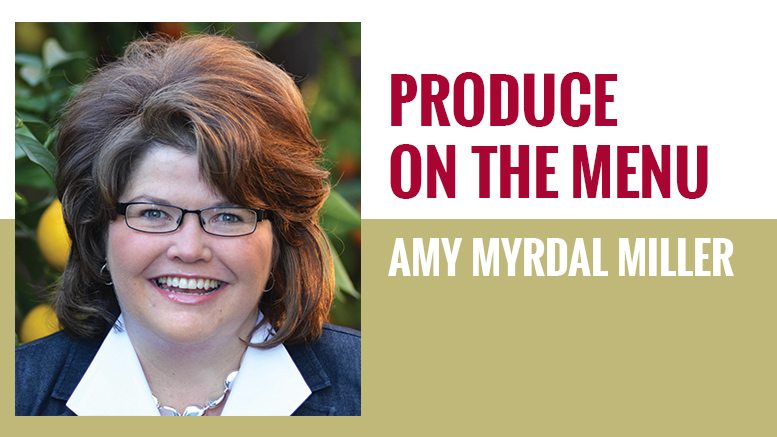Chef-Inspired Ideas For Making Vegetables Craveable
January 2, 2020 | 4 min to read
At the 2019 New York Produce Show, Chef Ron DeSantis showcased how herb-based sauces can transform vegetables, highlighting Mann Packing’s Caulilini baby cauliflower. He presented sauces like Chermoula, Green Goddess dressing, Gremolata, Romesco, and Zhoug, emphasizing their ability to enhance flavors and sensory appeal. Chef DeSantis encouraged chefs to incorporate these flavorful additions, making vegetables more enticing and ensuring they become the stars of the meal.

Originally printed in the January 2020 issue of Produce Business.
Chef Ron DeSantis, Certified Master Chef (CMC) and principal advisor at CulinaryNxt, led a compelling culinary demonstration at the 2019 New York Produce Show’s Ideation Fresh Foodservice Forum. Chef DeSantis focused on the use of herb-based sauces to add “flavor bursts” to vegetables.
His featured vegetable was Mann Packing’s Caulilini baby cauliflower. Every chef I know who’s seen Caulilini is instantly eager to try it on his or her menu, and after watching Chef DeSantis’ demo, I was eager to share his sauce secrets.
During the demo Chef DeSantis casually commented on steamed broccoli, noting no one is super excited about a side of steamed vegetables. But once a chef adds a sauce the perception of the vegetable changes, especially when the sauce offers incredible sensory benefits like bright color contrast, alluring aromas and incredible bursts of flavor.
Here are the sauces he highlighted:
CHERMOULA
Chermoula is a North African sauce that can also be used as a dressing or marinade. It’s most typically associated with Moroccan cuisine, but it’s also used in kitchens from Algeria and Tunisia to Libya. The recipe varies by country and cook, but the basic ingredients include garlic, parsley, mint or cilantro, lemon juice or vinegar and olive oil. Spices like cumin add beautiful aroma, cayenne adds heat and paprika contributes color. Some chefs include preserved lemon for briny, salty flavors.
Chermoula works well on nearly any grilled or roasted vegetable. It’s also a wonderful addition tossed into cauliflower rice, couscous, chickpeas or beans. Chef Joyce Goldstein in her Mediterranean Fresh cookbook features Chermoula thinned with additional lemon juice as a dressing for a variety of fresh vegetables and salads. I love it with fresh tomatoes as a very simple summer salad.
GREEN GODDESS DRESSING
The origins of this dressing or sauce are often attributed to a chef at the Palace Hotel in San Francisco who created the dressing in 1923 as a tribute to an actor who starred in The Green Goddess play that toured the United States and was featured on Broadway in the early 1920s.
The dressing gets its green hue from scallions, parsley, tarragon and chives. Mayonnaise provides a creamy richness, anchovies provide salt, and vinegar contributes acid to balance the overall flavor profile.
Green Goddess dressing has enjoyed resurgence in popularity recently, appearing on restaurant menus as a salad dressing, dip and sandwich spread. Panera features it on its ever-popular Green Goddess Cobb with Chicken. California-based restaurant chain Lazy Dog Restaurant & Bar features it in its aptly named Green Goddess Salad topped with eye-catching watermelon radishes. Perhaps Chef DeSantis’ demo will inspire more chefs to add this California classic to their menus to increase the appeal of wide variety of vegetables.
GREMOLATA
Gremolata is a chopped herb condiment or garnish that originated in Milan, Italy. Gremolata is so simple, made with just parsley, garlic, and lemon zest. Adding it to roasted asparagus or vegetable-based soups, for example, will brighten aromas and flavors, enticing the diner to take yet another bite. Chef Joyce Goldstein suggests using orange zest in place of the lemon zest and pairing with roasted potatoes.
ROMESCO
This classic sauce originated in the Catalan region of Spain where it is most often paired with grilled spring onions. Spaniards talk passionately about dragging the onions through the Romesco sauce, tilting back their heads and savoring every delicious mouthful. Romesco features roasted red bell peppers, raw or roasted tomatoes and garlic. Extra virgin olive oil and finely ground nuts like toasted almonds and hazelnuts add creamy richness, while smoked pimentón pepper adds an alluring aroma. Some recipes include vinegar for flavor balance, and many cooks will add salt, again to balance the flavor of the sauce. I love using Romesco on roasted potatoes, as a sandwich spread, and as a topping for bowls loaded with whole grains, fresh produce and grilled meat or poultry.
ZHOUG
The final star of Chef DeSantis’ demo was zhoug, a spicy cilantro-based sauce that originated in Yemen and is used across Middle Eastern countries to add addictive heat to vegetables or grain-based dishes. Some refer to it as Middle Eastern pesto or chimichurri. Fresh green chiles like jalapenos and serranos add heat while extra virgin olive oil and vinegar balance the flavor. Some cooks add cardamom for an alluring lemon flavor and comforting aroma. Chef DeSantis exclaimed, “It’s spicy,” and he’s right. Zhoug captures — and holds — your attention. It’s the perfect accompaniment for roasted cauliflower or potatoes. It’s also a great dip for fresh vegetables when mixed with a little Greek yogurt.
Let’s make 2020 the year that no vegetable goes without an accompanying “flavor burst” that makes the vegetable the first thing to disappear from the plate, bowl or grazing board.

Amy Myrdal Miller, MS, RDN, FAND is a farmer’s daughter from North Dakota, award-winning dietitian, culinary nutrition expert, and founder and president of Farmer’s Daughter Consulting, Inc. She is the director of The Culinary Institute of America Healthy Menus R&D Collaborative and a consultant for the Produce for Better Health Foundation. You can learn more about her business at www.farmersdaughterconsulting.com, and you can follow her insights on food and flavor on social media @AmyMyrdalMiller
3 of 12 article in Produce Business January 2020

